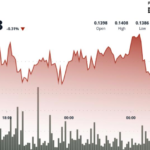Bitcoin is currently navigating a cautious trading range, fluctuating between approximately $109,000 and $124,000 over the past ten weeks. Investors are closely monitoring potential leadership changes at the U.S. Federal Reserve, as a new, dovish chair could ignite a bullish surge for the cryptocurrency.
Galaxy Digital’s CEO, Mike Novogratz, emphasized that a significantly dovish Fed chair might be the most substantial catalyst for Bitcoin and the overall crypto market. He suggested that aggressive easing could fuel a rapid rally in Bitcoin prices, potentially provoking conversations about new all-time highs. However, he caution that such a monetary policy shift could come with significant repercussions for the U.S. economy and the Fed’s independence.
President Donald Trump has indicated a preference for a more dovish candidate for Fed chair, with names like Kevin Hassett, Christopher Waller, and Kevin Warsh emerging as contenders on a reducing shortlist. Waller, in particular, has advocated for earlier rate cuts in the past, a stance that is generally viewed favorably by markets as it tends to weaken the dollar while benefiting risk assets like Bitcoin.
On a technical basis, Bitcoin’s price action remains fragile. It has experienced a 5% decline over the past week and is currently trading around $109,000. Analysts from Swissblock pointed out that Bitcoin has been largely range-bound during the past ten weeks, bouncing between the aforementioned price points. Their risk models suggest the market has entered a destabilization phase but is beginning to show early signs of stabilization.
Despite Bitcoin’s decline below $110,000, key indicators suggest that the broader market dynamics remain intact. Bitcoin had a prior local low of around $107.3K, which was reached during an earlier correction in August, but the market structure appears to be holding steady. Some analysts believe Bitcoin is potentially preparing for another uptick.
The Swissblock team reported that long-term holders are slowing their selling activity. Additionally, investments from ETFs and treasuries are continuing to support the market’s base. Their “Aggregated Impulse” indicator, derived from analyzing numerous digital asset price structures, indicates the market may be resetting itself. Historically, similar indicators have marked pivotal lows and triggered significant rebounds in both Bitcoin and altcoins.
As the market moves into October and November, historically favorable months for crypto, a potential easing cycle from the Fed could serve as a macroeconomic tailwind. If the next Fed chair adopts a dovish approach, it could lead to a weaker dollar and falling yields, further motivating investors to seek returns in the cryptocurrency market.
In summary, Bitcoin’s trajectory in the near future may hinge not only on internal market dynamics but also significantly on the upcoming Federal Reserve leadership and monetary policy direction. Investors are urged to stay informed and consider the volatility and unpredictability of the current market landscape.







